Cybersecurity risks in healthcare are predominantly triggered by the medical industry’s unspoken rule of doing more with less. Hardly anyone can blame them for this: there’s always little budget for healthcare software development and practically no money for hardware substitutes. When trying to survive through the rules and limitations, the do-more-with-less approach seems like the only possible way out.
However, the 2020s have brought changes to the whole industry and beyond. With Artificial Intelligence, Machine Learning algorithms, and cloud computing in healthcare, hospitals, clinics, and patients administer better, treat more effectively, and recover faster. Yet, with new technologies, there are new threats and challenges, including the risk of hospital cyber attacks and medical network security issues.
In this blog post, we’ll examine healthcare cybersecurity challenges and offer some tips for overcoming them. Remember that no matter how complicated things may seem, healthcare and cybersecurity can co-exist if a tech team knows how to unite them.

Phishing
Phishing is one of the most challenging healthcare cybersecurity threats. What is phishing? It is a way to infect users with malicious links, usually through emails. Such emails typically reference a medical topic or software familiar to the recipient to trick them into clicking a link. Once the user clicks the link, they are directed to a decoy website with a fake login screen. After a user submits their credentials, hackers use them to access the medical software and data it holds.
Phishing has the biggest financial impact among all medical cyber attacks. This is why it should be prevented through multiple healthcare IT security initiatives.
Ransomware Attacks
A ransomware attack is malware injected into a healthcare system to infect all sensitive data and then encrypt it. The data is then held hostage until a ransom is paid. More and more healthcare providers have experienced ransomware attacks: for instance, in 2020, one in three healthcare institutions was the victim of such attacks. Such attacks cause panic and fear of regulatory after-effects that follow patient data thefts.
What is peculiar is that the wide adoption of modern technologies has fueled the growth of ransomware attacks in the healthcare sector.
Cloud Threats
Health management organizations are commonly using cloud computing for the following processes:
- Communication
- Collaboration
- Data storage
- Data management
However, regardless of the value it brings to end users, it carries risks. The main one is that not all cloud-based solutions follow compliance regulations. Cloud threats compromise financial, personal, and medical data.
Cloud-based medical cybersecurity challenges also pose a vendor lock-in threat: the inability to switch between providers.

Data Breaches
Even though HIPAA specifies strict health data protection requirements, most medical software programs in healthcare have serious security gaps and leave entry points for hackers, threatening patients’ data safety. Yet, identifying such gaps and vulnerabilities is straightforward. It is enough to use special monitoring tools. Such tools also address 3rd party vendor networks, as such threats can facilitate indirect sensitive data access to:
- Names
- Addresses
- Phone numbers
- Credit card numbers
- Social security numbers
- Medical device intellectual property
- Lab tests
- Clinical notes
- Prescription Information
One of the biggest attacks occurred between January 18 and February 24, 2022, when hackers gained unauthorized access to ARcare’s software and stole sensitive data.
DDoS Attacks
Distributed denial-of-service attacks (DDoS attacks) are fake connection requests that force a specific server to go offline. When this type of cybersecurity issue in healthcare occurs, devices at endpoints are recruited to participate in a collaborative seizure. Of course, DDoS attacks do not boast the same data leakage consequences, but they do have adverse operational effects, including:
- Revenue loss
- Downtime
- Reduced productivity
- High recovery costs
Many modern ransomware models include DDoS elements due to the immense speed and devastation they create for cybersecurity in healthcare.

Insider Threats
Insider threats are often referred to as internal cybersecurity threats in healthcare and occur directly from medical personnel with access to network users and servers. Internal thieves plan to either gain unauthorized access control or harm a specific facility. However, this can be done unintentionally when an employee simply neglects security protocols. Like any other threat to cybersecurity in the healthcare industry, insider threats have serious consequences both for medical businesses and patients.
Did you know that most employees lack security awareness training? 39% receive proper training less than once a year.
Unprotected IoT Devices
Combine big data, IoT, and cloud computing, and you’ll see a new world of awesome possibilities for healthcare. However, these innovations don’t consider cybersecurity for hospitals and healthcare facilities. On the contrary, they often overlook this crucial need. Most IoT devices at hospitals and clinics used for analytics, diagnostics, ultrasound, and more run on outdated software, which puts all data at the highest risk.
Another significant issue is the speed of progress. During the COVID-19 pandemic, telemedicine grew many times over. Artificial Intelligence, Machine Learning, and virtual reality have pivoted many medical businesses to remote caregiving. And since this was done almost overnight, the number of healthcare network security threats grew.
At the very start of COVID-19, back in 2020, Forbes stated that healthcare became the 7th most targeted industry in terms of cyberattacks and criminals.
Fragmented Security Architecture
Understanding the importance of cybersecurity in healthcare, hospitals establish special cybersecurity programs but often leave them underdeveloped or built on a long list of different security products. It is estimated that over 80% of all US healthcare institutions rely on this fragmented security architecture with at least ten different products.
Healthcare organizations must aggregate all the products with the on-premise ecosystem to enable a single-pane-of-glass-vide of the entire infrastructure.

Identity Theft
When personal information is stolen, it is called identity theft. This leads to major financial losses for healthcare organizations and individuals and a ruined reputation and medical history for the victim. The introduction of powerful authentication measures helps to prevent this cybersecurity challenge in healthcare.
How do patients know someone has been using their identity?
- They get a bill for services they didn’t get.
- They receive calls from debt collectors regarding their medical debt.
- They see suspicious medical debt collection notices in their credit card reports.
- Their health insurance company sends them a notice that they have reached their benefit limit.
Thieves require a patient’s social security number and medical insurance data to acquire one’s medical identity. If healthcare cybersecurity regulations are met and a system is well-protected, so is this data.
Compliance Regulations
Healthcare cybersecurity compliance is crucial for medical organizations to safeguard their patient data. The core regulations that healthcare institutions need to adhere to are those outlined by CISA (the Cybersecurity and Infrastructure Security Agency), HIPAA, and HHS (the US Department of Health and Human Services). Due to the nature and complexity of the healthcare industry, these regulations are often challenging. However, compliance is the only way to prevent breaches and avoid financial or legal consequences.
With the evolution of AI, it is crucial to follow core AI regulations if this technology is part of the healthcare software used by employees and patients.
IT Support
Healthcare cybersecurity’s best practice is having an in-house IT department responsible for medical device and software governance, possible challenges, and attacks. Unfortunately, few healthcare institutions are blessed with such. This is why cybersecurity challenges and cyberattacks are so frequent. To cut down expenses, some hospitals and clinics hire offshore or nearshore development teams for support as well as compliance maintenance.
Offshore and nearshore IT companies help institutions of all sizes and specialties, working across technologies from computer vision to data mining and NLP to IoT.
Unprotected Third-Party Vendor Access
Most healthcare institutions lack a budget for in-house employment, so they outsource part of their operations to different service providers, like call centers. Every extra entity included in daily operations increases the risks of data breaches. To minimize risks, it is important to choose reliable vendors bound by a service-level agreement with secure remote access to medical software.
Typical third-party vendors for the healthcare sector are Medicaid, Medicare, and commercial insurance, which need to meet a set of conditions to get access to medical data. A hospital or clinic can deal with several providers simultaneously.
Bottom Line
There’s no doubt that technology helps healthcare providers deliver better services and helps patients improve their lives in terms of duration and quality. However, the main challenge is that healthcare is a 24/7/365 domain. Any downtimes and issues bring major disruptions. This is why healthcare industry cybersecurity must be a priority.
If you are a public or private healthcare institution in need of a new cybersecurity system or an upgrade to an outdated one, our team is here to consult with you. Let’s talk about what your business needs and plan the perfect solution.





